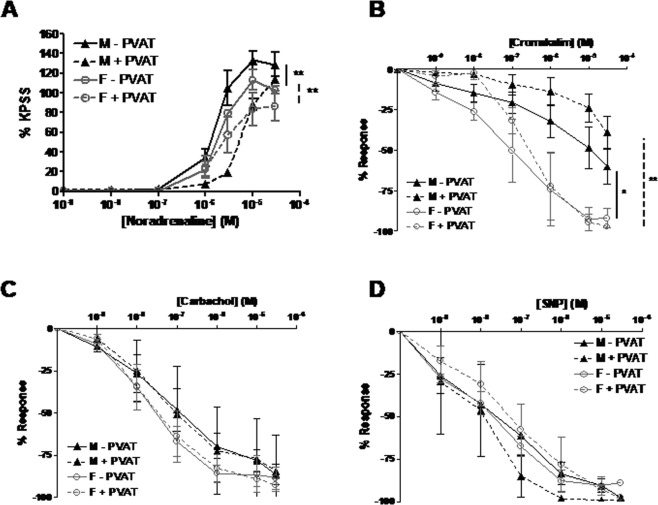Figure 1.
Male and female SHRSP exhibit different third-order mesenteric artery function in the absence and presence of PVAT. Wire myography was used to assess mesenteric artery function in age-matched (16 weeks old) male (n = 5) and female (n = 5) SHRSP. PVAT had an anti-contractile effect in both male and female (A). Vessels from male SHRSP - PVAT were more responsive to noradrenaline than vessels from female SHRSP - PVAT (A) (**p < 0.01; EC50 SHRSP male 1.84 ± 1.30 μM vs. SHRSP female 3.43 ± 0.41 μM followed by one way ANOVA and post-hoc Tukey test) (A). In addition, vessels from male SHRSP + PVAT were more responsive to noradrenaline than vessels from female SHRSP + PVAT (**p < 0.01; EC50 SHRSP male 6.13 ± 0.82 μM vs. SHRSP female 12.35 ± 1.27 μM followed by one way ANOVA and post-hoc Tukey test) (A). Vasorelaxation to cromakalim was impaired in vessels – PVAT from male SHRSP relative to vessels – PVAT from female SHRSP (*p < 0.05; area under the curve followed by one way ANOVA and post-hoc Tukey test) and in vessels + PVAT from male SHRSP relative to vessels + PVAT from female SHRSP (**p < 0.01; area under the curve followed by one way ANOVA and post-hoc Tukey test) (B). There was a trend for endothelium-dependent vasorelaxation to carbachol to be greater in vessels from female relative to male SHRSP; PVAT did not induce a significant difference in carbachol response in either strain (C). Vasorelaxation to SNP was not significantly different between strains; PVAT did not significantly alter the response to SNP in either strain (D).

